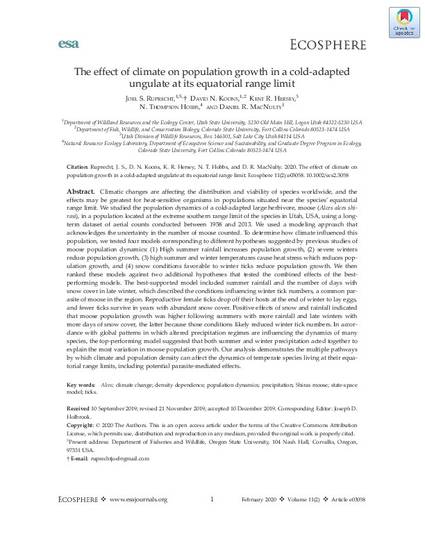
Article
Effect of climate on population growth in a cold‐adapted ungulate at its equatorial range limit
Ecosphere
(2020)
Abstract
Climatic changes are affecting the distribution and viability of species worldwide, and the effects may be greatest for heat‐sensitive organisms in populations situated near the species’ equatorial range limit. We studied the population dynamics of a cold‐adapted large herbivore, moose (Alces alces shirasi ), in a population located at the extreme southern range limit of the species in Utah, USA , using a long‐term dataset of aerial counts conducted between 1958 and 2013. We used a modeling approach that acknowledges the uncertainty in the number of moose counted. To determine how climate influenced this population, we tested four models corresponding to different hypotheses suggested by previous studies of moose population dynamics: (1) High summer rainfall increases population growth, (2) severe winters reduce population growth, (3) high summer and winter temperatures cause heat stress which reduces population growth, and (4) snow conditions favorable to winter ticks reduce population growth. We then ranked these models against two additional hypotheses that tested the combined effects of the best‐performing models. The best‐supported model included summer rainfall and the number of days with snow cover in late winter, which described the conditions influencing winter tick numbers, a common parasite of moose in the region. Reproductive female ticks drop off their hosts at the end of winter to lay eggs, and fewer ticks survive in years with abundant snow cover. Positive effects of snow and rainfall indicated that moose population growth was higher following summers with more rainfall and late winters with more days of snow cover, the latter because those conditions likely reduced winter tick numbers. In accordance with global patterns in which altered precipitation regimes are influencing the dynamics of many species, the top‐performing model suggested that both summer and winter precipitation acted together to explain the most variation in moose population growth. Our analysis demonstrates the multiple pathways by which climate and population density can affect the dynamics of temperate species living at their equatorial range limits, including potential parasite‐mediated effects.
Disciplines
Publication Date
2020
DOI
https://doi.org/10.1002/ecs2.3058
Citation Information
Dan R. MacNulty. "Effect of climate on population growth in a cold‐adapted ungulate at its equatorial range limit" Ecosphere Vol. 11 Iss. 2 (2020) p. e03058 Available at: http://works.bepress.com/dan_macnulty/90/
